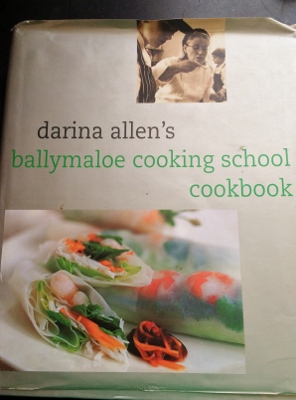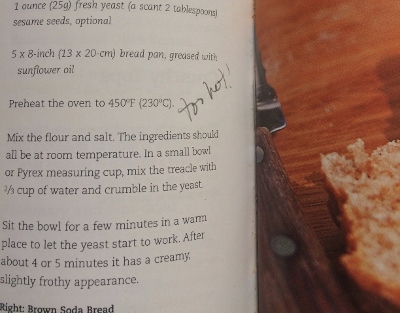Life-Changing Cookbooks: Darina Allen’s Ballymaloe Cooking School Cookbook
Paste's column on the cookbooks that shape who we are.
Photos by Carrie Havranek Books Features cookbooksI didn’t have one of those formative, tugging-at-mom’s apron strings experiences that characterize so many people’s first encounters with cooking. Instead, I learned how to bake first, before I even learned how to boil water. I acquired basic cooking skills in college, which sustained me through to my mid-20s, by which point I owned about a half dozen cookbooks, including How to Cook Everything, which is dog-eared, splattered and broken-spined.
Something flipped when I moved in with my now-husband. I didn’t magically turn into Miss Domesticity, but remarkably, my foray into becoming what I like to call a Serious Kitchen Person emerged organically, without a whole hell of a lot of reflection. Maybe because feeding ourselves is one of those tasks we perform out of necessity (and I was still a music writer back then, dying to become the next Ann Powers or, before her, Ellen Willis), I couldn’t possibly have conceptualized the route. There was, however, a pivotal event that solidified my love of cooking and projected me onto my path: my honeymoon in Ireland and Darina Allen’s Ballymaloe House Cooking School Cookbook.
We didn’t just pick Ballymaloe House on a lark. I had been baking scones and other easy things from the slim little volume Myrtle Allen Cooks at Ballymaloe House, which a friend bought for me sometime after college. (Maybe this was the gateway cookbook?) I knew about this destination in Shanagarry in the south of Ireland, about 40 minutes slightly southeast from Cork city center. Myrtle Allen is often considered the Julia Child of Ireland and compared to Alice Waters; the stone, ivy-covered Georgian inn, Ballymaloe House, is located on a working farm that feeds the stellar restaurant. Allen was way ahead of her time, and not because of the whole farm-to-table ethos. Ireland’s compact nature and agricultural roots tend to facilitate that fairly easily, even though its grocery stores weren’t necessarily oriented toward supporting local farmers. Most chefs in the 1960s were not rewriting their menus on a daily basis to prioritize fresh and local offerings, but Myrtle Allen was.
We honeymooned in Ireland, a place I nearly lost my husband to years ago, so deep is his affection for the country. For about a thousand bucks per person, we bought a package that included airfare and two weeks of bed and breakfast vouchers. We decided to ditch the vouchers for a couple of nights and made reservations for Ballymaloe before we left. For dinner on our first night, I ate freshly caught cod (from less than ten miles away at Ballycotton) in a mustard sauce, served with beets. I don’t think I knew I was eating at a restaurant that once received a Michelin star, but I knew the place mattered. I can still picture the vivid contrast, the way the shocking magenta hue swirled in with electric yellow mustard. The dish, along with the cart of gorgeous local cheeses that was wheeled out after dinner, impressed itself upon me, but it was more of indelible imprint, one whose full impact took time to surface.
Several months later Darina Allen Ballymaloe Cooking School Cookbook was released, written by Myrtle’s daughter-in-law and a celebrity chef in her own right. Later that year, my husband gave it to me for Christmas. I immediately started with the recipe for brown bread—a whole wheat-based soda bread, and a hearty, Irish breadbasket staple. The recipe doesn’t call for wholemeal flour, which is more authentic, but I suspect in 2002 that ingredient had not yet started appearing on grocery shelves the way it does now. I then progressed to the brown yeast bread and honestly can’t remember what was next. I may have become distracted by another Ballymaloe book. But that’s another story.

I couldn’t get enough of the book. I read it at night, in bed, I read it with a cup of tea (whatever Irish breakfast I had leftover from our trip), I read it whenever I wanted to be transported. The chapters are preceded by snippets of practical information about farm living and produce growing and kitchen wisdom culled from Allen’s 20 years of running Ireland’s premier cookery school and 100-acre farm at a pivotal moment in the country’s food history. The book isn’t just a paean to the Irish countryside and its bounty—it’s modern Irish fare, rooted in French culinary traditions, infused with flavors of the world’s cuisines.
The international influence of the school’s guest cooks, students, friends and friends-as-family are given props in headnotes, and mean you’ll find Thai chicken soup, dal makhani and Vietnamese spring rolls just as easily as homemade pasta and boeuf Bourguignonne and a good old-fashioned roasted turkey. I know everyone and their favorite chef brines, brines, brines, but my family is stuck on the method of moisture retention that Darina Allen puts forth: soak a cheesecloth in good, melted butter and drape it over the turkey. We use Kerrygold’s garlic and herb butter. An entire stick of European cultured butter chockablock with chives, garlic and parsley. This past Thanksgiving, I almost relented and brined instead, but something kept tugging me back. It’s now the way we cook the turkey—who wants to mess with success?
Turkey talk aside, what I find myself most consistently turning to are the distinctively Irish recipes. Those brown breads, whether yeasted or soda. And learning that “spotted dog” is what most Americans consider Irish soda bread, and about its companion, Stripy Cat, which subs chocolate chips for the raisins. The Winter Leek and Potato Soup with its cool trick of advising you to put a “paper lid” (a parchment round) over the stock pot and then clamping the lid over it to keep in the steam as the veggies cook. To a gal in her late 20s with no professional kitchen experience (waitressing is the other side of the line) and with an ailing mother two hours away who hadn’t yet relapsed into cancer but who wasn’t cooking much and was therefore figuring much of this out on her own, it was a revelation. Those were formative, a-ha moments of kitchen education.

I also quickly learned that recipes written in Ireland for bread and baked goods will likely need more moisture—there’s more ambient humidity in Ireland on any given day than my home in Pennsylvania. I learned to knock down the heat a little bit and up the liquids in bread recipes, tentatively at first, and then scribble the altered instructions in the margin. Some might consider the necessity of my interjection as a sign that the recipes don’t work. The recipes worked—they just needed some American tweaking. This cookbook provided me lessons both straightforward and sneaky, plus a chance to develop my kitchen intuition. Unbeknownst to me at the time, it was the beginning of my path toward becoming a serious home cook and baker, a food writer and an aspiring cookbook author with a dozen scone recipes running around my head at any given moment. I fall in love with Ireland again and again when I read it; it makes me want to own chickens or become a cheesemaker. Fortunately, I have access to splendid specimens of both where I live, culled from less than 20 miles away. I have become almost annoyingly evangelical about fresh, local and, when possible, organic food, and it’s all because of my honeymoon in Ireland, the visit to Ballymaloe House and the bit of it that lives on in my kitchen, from Darina Allen’s book.
Serendipitously, Ballymaloe House celebrated its 50th anniversary last spring, the same day Myrtle Allen celebrated her 90th spin around the sun: March 13. Happy Birthday, Myrtle Allen. Hope you rock 91.

Carrie Havranek is a recovering music critic and part-time baker who writes about food, farmers’ markets, chefs and restaurants—and sometimes travel—from her home in Easton, Pennsylvania. You may have seen her work elsewhere in Edible Philly, the Kitchn, or Frommer’s.